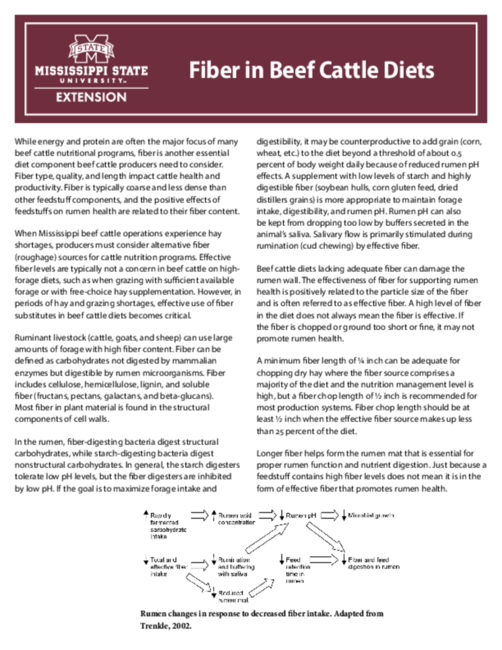P2489
Fiber in Beef Cattle Diets
Download the complete publication by selecting the publication image in the right column.
While energy and protein are often the major focus of many beef cattle nutritional programs, fiber is another essential diet component beef cattle producers need to consider. Fiber type, quality, and length impact cattle health and productivity. Fiber is typically coarse and less dense than other feedstuff components, and the positive effects of feedstuffs on rumen health are related to their fiber content. When Mississippi beef cattle operations experience hay shortages, producers must consider alternative fiber (roughage) sources for cattle nutrition programs. Effective fiber levels are typically not a concern in beef cattle on high-forage diets, such as when grazing with sufficient available forage or with free-choice hay supplementation. However, in periods of hay and grazing shortages, effective use of fiber substitutes in beef cattle diets becomes critical.
This publication explains that fiber includes carbohydrates not digested by mammalian enzymes but digestible by rumen microorganisms, such as cellulose, hemicellulose, lignin, and soluble fibers. Fiber-digesting bacteria in the rumen digest structural carbohydrates, while starch-digesting bacteria digest nonstructural carbohydrates. Diets with too much grain can lower rumen pH and inhibit fiber digesters, so supplements with low starch and highly digestible fiber are preferred to maintain forage intake and rumen health. Effective fiber is not just about fiber quantity but also particle size; a minimum fiber chop length of ½ inch is recommended when fiber sources comprise less than 25% of the diet to promote rumen health.
Longer fiber promotes formation of the rumen mat essential for digestion and stimulates cud chewing with saliva production, which buffers rumen pH. While some high-fiber feeds like soybean hull pellets are high in digestible fiber, they have low effective fiber due to small particle size and should not be used exclusively as a forage replacement. The concept of effective fiber, expressed as effective neutral detergent fiber (eNDF), is important to maintain rumen pH and cattle feed intake. High-energy finishing diets require about 8% eNDF to keep rumen pH above 5.7, avoiding health issues like acidosis. Proper bunk management and ionophores can help manage rumen pH fluctuations and reduce effective fiber needs.
You can also contact state Extension specialists or your local Extension office for answers to specific questions.
Publication 2489 (POD-10-25)
Reviewed by Brandi Karisch, PhD, Associate Extension/Research Professor, Animal and Dairy Sciences. Written by Jane A. Parish, PhD, Professor and Head, North Mississippi Research and Extension Center; and Justin D. Rhinehart, PhD, former Assistant Extension Professor, Animal and Dairy Sciences.
The Mississippi State University Extension Service is working to ensure all web content is accessible to all users. If you need assistance accessing any of our content, please email the webteam or call 662-325-2262.
